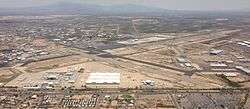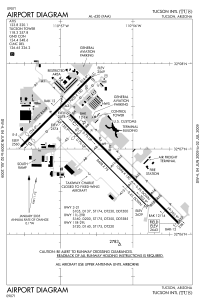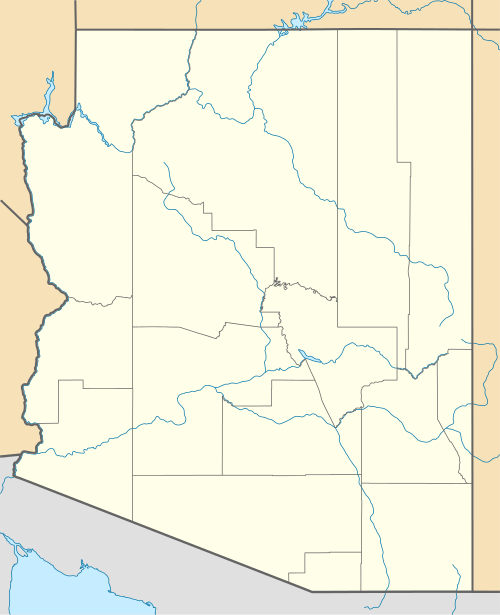Tucson International Airport
| Tucson International Airport | |||||||||||||||||||
|---|---|---|---|---|---|---|---|---|---|---|---|---|---|---|---|---|---|---|---|
 | |||||||||||||||||||
 | |||||||||||||||||||
| IATA: TUS – ICAO: KTUS – FAA LID: TUS | |||||||||||||||||||
| Summary | |||||||||||||||||||
| Airport type | Public | ||||||||||||||||||
| Owner | City of Tucson | ||||||||||||||||||
| Operator | Tucson Airport Authority | ||||||||||||||||||
| Serves | Tucson, Arizona | ||||||||||||||||||
| Elevation AMSL | 2,643 ft / 806 m | ||||||||||||||||||
| Coordinates | 32°06′58″N 110°56′28″W / 32.11611°N 110.94111°WCoordinates: 32°06′58″N 110°56′28″W / 32.11611°N 110.94111°W | ||||||||||||||||||
| Website | www.flytucson.com | ||||||||||||||||||
| Maps | |||||||||||||||||||
 FAA airport diagram (June 2009) | |||||||||||||||||||
 TUS Location of airport in Arizona | |||||||||||||||||||
| Runways | |||||||||||||||||||
| |||||||||||||||||||
| Helipads | |||||||||||||||||||
| |||||||||||||||||||
| Statistics (2015) | |||||||||||||||||||
| |||||||||||||||||||
Tucson International Airport (IATA: TUS, ICAO: KTUS, FAA LID: TUS) is a public joint civil-military airport owned by the City of Tucson 8 mi south of downtown Tucson, in Pima County, Arizona.[1] It is the second busiest airport in Arizona, after Phoenix Sky Harbor International Airport.
The National Plan of Integrated Airport Systems for 2011–2015 categorized it as a primary commercial service airport since it has over 10,000 passenger boardings per year.[4] Federal Aviation Administration records say the airport had 1,779,679 enplanements in 2011, a decrease from 1,844,228 in 2010.[5]
Tucson International is operated on a long-term lease by the Tucson Airport Authority, which also operates Ryan Airfield, a general aviation airport. Tucson International Airport is not a hub or focus city for any airline. Public transportation to the airport is Sun Tran bus routes No. 6 and No. 25.
History
In 1919 Tucson opened the first municipally owned airport in the United States. In 1928 commercial flights began with Standard Airlines (later American Airlines); regular airmail service began in 1930. The 1936 airport directory shows Tucson Municipal at 32°11′N 110°55′W / 32.183°N 110.917°W "just north of the railroad" (since removed) referring to the site that was then being used as the city's airport southeast of the intersection of S. Park Ave. and E. 36th St.
During World War II the airfield was used by the United States Army Air Forces Air Technical Service Command. A contract flying school was operated by the USAAF West Coast Training Center from July 25, 1942 until September 1944.
In 1948 the Tucson Airport Authority was created as a non-profit corporation to operate the airport and oversee policy decisions. The nine member board is elected by a group of up to 115 volunteer residents from Pima County Arizona. The airport was moved to its current location south of Valencia Road and operated on the west ramp out of three hangars vacated by World War II military manufacturing companies. A new control tower was constructed in 1958 to replace the original WWII wooden framed version.
The Tucson Airport Authority was also involved in bringing the Hughes Missile Plant (now Raytheon) to Tucson. In fact, in 1951, according to author David Leighton, it was the TAA that sold the land to the Hughes Aircraft Co., for construction of the plant.[6]
In March 1956, the Civil Aeronautics Board approved routes out of Tucson for Trans World Airlines (TWA), in spite of opposition from the already established American Airlines but it wouldn't be until December of that year that the first planes began service.[7]
In April 1957 airlines scheduled 21 departures a day: 15 American, 4 TWA and 2 Frontier. The first jet flights were operated by American Airlines with Boeing 707 and Boeing 720B jetliners around September 1960. During the mid and late 1970s, American was flying wide body McDonnell Douglas DC-10 jets nonstop to Dallas/Ft. Worth [8] and also to Chicago via an intermediate stop in Phoenix.[9] By the late 1980s, American was operating Boeing 767-200 wide body jetliners from the airport with nonstop service to Dallas/Ft. Worth.[10] The DC-10 and 767 were the largest jetliners ever to serve Tucson with scheduled passenger flights.
On November 15, 1963 a new terminal designed by Terry Atkinson opened with an international inspection station. The Tucson International Airport[11][12] name was legitimate: Aeronaves de Mexico had begun Douglas DC-6 propliner service to Hermosillo and beyond in 1961. By the mid 1970s, successor airline Aeromexico was continuing to serve Tucson with McDonnell Douglas DC-9-30 jet flights nonstop to Hermosillo with direct, no change of plane service to Ciudad Obregon, Culiacan, Guadalajara and Mexico City.[13] Bonanza Air Lines began DC-9 jet service to Mexico as well during the late 1960s with flights to Mazatlan, La Paz and Puerto Vallarta,[14] and successor airlines Air West and Hughes Airwest also operated DC-9 jet flights from Tucson to Mexico with their service being extended to Guadalajara as well as continuing to provide flights to Mazatlan, La Paz and Puerto Vallarta.[15][16] The terminal underwent minor remodeling during the 1960s and 1970s, and its interior was featured in the 1974 film Death Wish starring Charles Bronson.
From the early 1970s to the early 1980s, Cochise Airlines was based in Tucson. This commuter airline operated Cessna 402 and Convair 440 propliners as well as de Havilland Canada DHC-6 Twin Otter and Swearingen Metroliner turboprops during its existence. Cochise flew scheduled passenger service to a number of destinations in Arizona and southern California.
A remodeling in 1985 doubled the size of the terminal from 150,000 to 300,000 sq ft and rebuilt the concourse into separate, two-level structures with jet bridges.[17]
A Concourse Renovation Project was finished in 2005 – the last phase of a remodeling begun in 2000 that added 82,000 sq ft (7,600 m2) to ticketing and baggage claim designed by HNTB.[18] On March 19, 2008, the previous East and West concourses and gates were renumbered with the East Concourse becoming Concourse A: Gates A1 – A9, and the West Concourse becoming Concourse B: Gates B1 – B11.
In January 2014, the Tucson Airport Authority board approved a no-cost, 20-year property lease with the Federal Aviation Administration for property on which to build a new federally funded control tower to replace the 1950s vintage tower currently in use. Construction of the tower is expected to commence in July 2014. The new tower will be located on the south side of the airport, near Aero Park Blvd.
On April 6, 2016, the Tucson Airport Authority announced the Terminal Optimization Program (TOP). The program, which will go by its campaign name, A Brighter TUS, includes a variety of terminal facility improvements, including relocation and improved capacity at the Security Screening Checkpoints, enhanced concession and revenue opportunities, the upgrade of critical building systems, and maximizing use of under-utilized space. Renovations are to begin in June 2016 and are to be completed in November 2017.[19]
Military use
Tucson International Airport hosts Tucson Air National Guard Base, a 92-acre (37 ha) complex on the northwest corner of the airport that is home to the 162d Fighter Wing (162 FW), an Air Education and Training Command (AETC)-gained unit of the Arizona Air National Guard. The largest Air National Guard fighter unit in the United States, the 162 FW operates over 70 F-16C/D/E/F aircraft in three operational fighter squadrons. The wing provides training on the F-16 Fighting Falcon, augmenting the active Air Force's 56th Fighter Wing (56 FW) at Luke AFB, Arizona as a Formal Training Unit (FTU) for training Regular Air Force, Air Force Reserve Command, Air National Guard and NATO/Allied/Coalition F-16 pilots.
The wing also hosts the Air National Guard / Air Force Reserve Command (ANG AFRC) Command Test Center (AATC) as a tenant unit, which conducts operational testing on behalf of the Air Reserve Component. The 162 FW also hosts "Snowbird" operations during the winter months for Air Force, Air Force Reserve Command, and Air National Guard F-16 and A-10 units from northern tier bases in the continental United States, as well as Canadian Forces and Royal Air Force flying units.[20][21]
During its history at TUS, the 162nd has operated the F-86 Sabre, F-100 Super Sabre, F-102 Delta Dagger, A-7 Corsair II and F-16 Fighting Falcon aircraft. Not counting students or transient flight crews, the installation employs over 1,700 personnel, over 1,100 of whom are full-time Active Guard and Reserve (AGR) and Air Reserve Technician (ART) personnel, and the remainder traditional part-time Air National Guardsmen. Although an AETC organization, the 162nd also maintains an F-16 Alert Detachment for USNORTHCOM / NORAD and AFNORTH at nearby Davis-Monthan AFB in support of Operation Noble Eagle.
Facilities
The airport covers 7,938 acres (3,212 ha) at an elevation of 2,643 feet (806 m) above sea level. It has three asphalt runways and helipads:[1]
- Runway 11L/29R: 10,996 by 150 feet (3,352 x 46 m), with ILS
- Runway 11R/29L: 8,408 by 75 feet (2,563 x 23 m)
- Runway 3/21: 7,000 by 150 feet (2,134 x 46 m)
- Helipad H1: 100 by 100 feet (30 x 30 m)
- Helipad H2: 60 by 60 feet (18 x 18 m)
- Helipad H3: 60 by 60 feet (18 x 18 m)
Airlines usually use Runway 11L. In occasional trade winds, commercial airliners use Runway 29R, and even rarer, with south winds, Runway 21. Runway 11R-29L is too narrow for most commercial jet aircraft, but they can use Runway 3.
In the year ending April 30, 2012 the airport had 142,302 operations, average 389 per day: 47% general aviation, 25% airline, 15% air taxi, and 12% military. 303 aircraft were then based at the airport: 55% single-engine, 24% military, 10% multi-engine, 7% helicopter, and 4% jet.[1]
Terminal
Tucson International Airport's terminal has two concourses: Concourse A has nine gates, A1 through A9, and Concourse B has eleven gates, B1 through B11. Currently, Tucson International Airport offers daily nonstop airline service to 19 destinations across the U.S. and to Mexico.[22] Additionally, there are one-stop connections to more than 350 destinations around the world.
Both concourses inside the terminal offer food, beverage, and shopping as well as free wireless internet and charging stations.[23]
TIA versus TUS
There has been a propensity in local Tucson / Pima County area news media outlets (to include their weather reporting services) and other business and governmental entities in the Tucson metropolitan area outside of the professional aviation community to refer to the airport as "TIA" versus the airport's actual airport code of "TUS" in either reporting or reference. A similar situation occurs in the Tampa, Florida metropolitan area by that region's news media and other business and governmental entities with respect to their characterization Tampa International Airport (TPA). The airport code TIA is assigned to Tirana International Airport Nënë Tereza in Albania.[24]
Airlines and destinations
Passenger
| Airlines | Destinations | Concourse |
|---|---|---|
| Aeromar | Guadalajara, Hermosillo, Los Mochis, Mazatlán | A |
| Alaska Airlines | Seattle/Tacoma | B |
| Alaska Airlines operated by SkyWest Airlines | Seasonal: Portland (OR) | B |
| American Airlines | Chicago–O'Hare, Dallas/Fort Worth, New York–JFK | B |
| American Eagle | Los Angeles, Phoenix–Sky Harbor | B |
| Delta Air Lines | Atlanta Seasonal: Minneapolis/St. Paul | B |
| Delta Connection | Los Angeles, Salt Lake City Seasonal: Seattle/Tacoma | B |
| Southwest Airlines | Chicago–Midway, Denver, Las Vegas, Los Angeles, San Diego Seasonal: Houston–Hobby, Oakland | A |
| United Express | Denver, Houston–Intercontinental, Los Angeles, San Francisco Seasonal: Chicago–O'Hare | A |
Cargo
| Airlines | Destinations |
|---|---|
| DHL Aviation operated by Southern Air | Cincinnati |
| DHL Express operated by Ameriflight | Los Angeles |
| FedEx Express | Lubbock, Memphis |
Statistics
Top destinations
| Rank | City | Passengers | Carriers |
|---|---|---|---|
| 1 | Dallas/Fort Worth, Texas | 270,000 | American |
| 2 | Los Angeles, California | 212,000 | American, Delta, Southwest, United |
| 3 | Phoenix–Sky Harbor, Arizona | 187,000 | American/US Airways |
| 4 | Denver, Colorado | 168,000 | Southwest, United |
| 5 | Las Vegas, Nevada | 119,000 | Southwest |
| 6 | Atlanta, Georgia | 99,000 | Delta |
| 7 | San Diego, California | 79,000 | Southwest |
| 8 | Chicago–O'Hare, Illinois | 79,000 | American, United |
| 9 | Houston–Intercontinental, Texas | 71,000 | United |
| 9 | Chicago–Midway, Illinois | 70,000 | Southwest |
Airline market share
| Rank | Airline | Passengers | Share |
|---|---|---|---|
| 1 | Southwest Airlines | 967,000 | 31.21% |
| 2 | American Airlines | 703,000 | 22.66% |
| 3 | SkyWest Airlines | 672,000 | 21.69% |
| 4 | Mesa Airlines | 292,000 | 9.43% |
| 5 | Delta Air Lines | 250,000 | 8.07% |
Accidents and incidents
- On December 30, 1989, an America West Boeing 737-204 (Flight 450, Registration N198AW) was en route to the Tucson International Airport when a fire in the wheel well burned through hydraulic cabling. During landing braking was ineffective and the aircraft overran the end of the runway. After colliding with a concrete structure the plane came to a stop. Aircraft was written off.[26][27]
- On July 30, 1982, a Douglas C-47D (Registration N102BL) of Pronto Aviation Services was damaged beyond repair in a crash landing near El Paso International Airport following an engine failure shortly after take-off. The aircraft was on a domestic non-scheduled passenger flight to Tucson International Airport when the engine failed and the decision was made to return to El Paso. A single engine go-around was attempted following an unsafe landing gear warning.[28]
- On March 13, 1990, an Alaska Airlines Boeing 727-227 (Registration N271AF) operating Phoenix-Tucson, struck and killed a pedestrian during the takeoff roll at Phoenix International Airport. The man had apparently wandered away from a nearby mental hospital. How he made it onto runway 26L was not determined (Runway 26L is now 25R).[29]
- On February 7, 2016, a United Express Bombardier CRJ700 flying Tucson-Los Angeles filled with smoke upon departure from Tucson and was forced to make an immediate return to the airport and landed safely. None of the 77 people aboard were injured however passengers were forced to jump off of the aircraft's wings when the evacuation slides failed to properly activate [30][31]
References
- 1 2 3 4 FAA Airport Master Record for TUS (Form 5010 PDF)
- ↑ Tucson Airport Authority. Effective September 4, 2014.
- ↑ "Statistics". Tucson Airport Authority. January 2016. Retrieved July 22, 2016.
- ↑ "2011–2015 NPIAS Report, Appendix A" (PDF, 2.03 MB). faa.gov. Federal Aviation Administration. October 4, 2010.
- ↑ "Enplanements for CY 2011" (PDF, 1.7 MB). faa.gov. Federal Aviation Administration. October 9, 2012.
- ↑ David Leighton, The History of the Hughes Missile Plant In Tucson, 1947–1960, Private Publication, 2015 (Pg.4)
- ↑ David Leighton, The History of the Hughes Missile Plant In Tucson, 1947–1960, Private Publication, 2015 (Pgs.24 & 27)
- ↑ http://www.departedflights.com, Dec. 1, 1974 American Airlines system timetable
- ↑ http://www.departedflights.com, Jan. 20, 1979 American Airlines system timetable
- ↑ http://www.departedflights.com, Dec. 15, 1989 Official Airline Guide (OAG), Tucson flight schedules
- ↑ "Nov. 16: Today in Arizona History". Arizona Daily Star. November 16, 2011. Retrieved July 3, 2012.
- ↑ Architecture of the Modern Movement in Tucson, Arizona 1945–1975
- ↑ Feb. 1, 1976 Official Airline Guide (OAG), Tucson flight schedules
- ↑ http://www.timetableimages.com, April 28, 1968 Bonanza Air Lines system timetable
- ↑ http://www.timetableimages.com, July 1, 1968 Air West system timetable
- ↑ http://www.departedflights.com, July 1, 1972 Hughes Airwest system timetable
- ↑ "History of Tucson Airport Authority" (PDF). Tucson Airport Authority. 2014. Retrieved 12 May 2015.
- ↑ HNTB – Tucson Airport Expansion
- ↑ http://www.flytucson.com/includes/media/docs/Whats-New-at-TIA-4_6_16.pdf
- ↑ "ANG AFRC Command Test Center - Home".
- ↑ "162nd Wing, Arizona ANG - Home".
- ↑ "Airlines and Flights". TIA.
- ↑ "Travel Services". TIA.
- ↑ "A-Z World Airports Online - Albania airports - Tirana International Airport (TIA/LATI)". Arizona World Airports.
- 1 2 "RITA - BTS - Transtats". transtats.bts.gov. Retrieved November 22, 2016.
- ↑ "LAX90FA061". National Transportation Safety Board. December 30, 1989.
- ↑ Harro Ranter (December 30, 1989). "ASN Aircraft accident Boeing 737-204 N198AW Tucson International Airport, AZ (TUS)".
- ↑ "FTW82DA302". National Transportation Safety Board. July 30, 1982.
- ↑ "LAX90LA116". National Transportation Safety Board. March 13, 1990.
- ↑ http://www.tucsonnewsnow.com/story/31166523/united-airlines-makes-emergency-landing-this-weekend-at-tia
- ↑ http://www.abc15.com/news/region-central-southern-az/tucson/smoke-causes-emergency-landing-at-tucson-airport
- Other sources
-
 This article incorporates public domain material from the Air Force Historical Research Agency website http://www.afhra.af.mil/.
This article incorporates public domain material from the Air Force Historical Research Agency website http://www.afhra.af.mil/. - Manning, Thomas A. (2005), History of Air Education and Training Command, 1942–2002. Office of History and Research, Headquarters, AETC, Randolph AFB, Texas ASIN: B000NYX3PC
External links
| Wikimedia Commons has media related to Tucson International Airport. |
- Tucson International Airport, official website
- Non-stop routes from TUS, flight schedules
- Tucson International Airport (TUS) at Arizona DOT airport directory
- Aerial image as of October 2002 from USGS The National Map
- FAA Airport Diagram for Tucson International (TUS) (PDF), effective December 8, 2016
- FAA Terminal Procedures for Tucson International (TUS), effective December 8, 2016
- Resources for this airport:
- AirNav airport information for KTUS
- ASN accident history for TUS
- FlightAware airport information and live flight tracker
- NOAA/NWS latest weather observations
- SkyVector aeronautical chart for KTUS
- FAA current TUS delay information